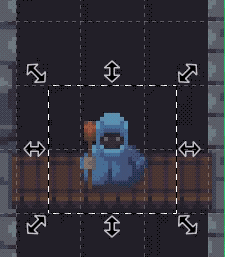What’s New
- Infinite Maps
- Bug Fixes
- API Changes
- Swift 5 Support
- tvOS Support
- Performance Increases
- Effects Rendering
- Support for Tiled Templates
- General Improvements
- GameplayKit
- New Object Types
- Custom Classes
Infinite Maps
SKTiled v1.3 supports inifinite maps. See the infinite maps section for more information.
Bug Fixes
A pesky, long-standing strong reference cycle memory leak is fixed, which will result in some code needing to be refactored in your projects if you use the TiledSceneDelegate protocol:
TiledSceneDelegate.tilemapproperty is now optionalTiledSceneDelegate.cameraNodeproperty is now optionalSKTiledSceneCamera.worldproperty is now optional
As a result, references to SKTilemap & SKTiledSceneCamera nodes will need to be unwrapped:
// API version 1.2
if let tiledScene = (self.view as? SKView)?.scene as? TiledSceneDelegate {
let renderSize = tiledScene.tilemap.sizeInPoints
let world = tiledScene.cameraNode.world
}
// API version 1.3
if let tiledScene = (self.view as? SKView)?.scene as? TiledSceneDelegate {
let renderSize = tiledScene.tilemap?.sizeInPoints
let world = tiledScene.cameraNode?.world
}
API Changes
There have been a number of important API changes, some of which will require refactoring in your projects. The new API is more efficient and features straightforward protocol design.
Tilemap Delegate
The TilemapDelegate (formerly SKTilemapDelegate) protocol is now an Objective-C protocol with optional methods. This was changed because of confusion when subclassing objects conforming protcols with default methods.
This might result in errors in Xcode:
To work around this, you’ll need to indicate that the delegate method is optional by marking it with a ?, and provide a default value:
// API version 1.2
if let delegate = tilemap.delegate {
let GraphNode = delegate.objectForGraphType(named: "floor-tiles")
let nodeAtCoordinate = GraphNode.init(gridPosition: simd_int2(coordinate.x - offset.x, coordinate.y))
}
// API version 1.3
if let delegate = tilemap.delegate {
let GraphNode = delegate.objectForGraphType?(named: "floor-tiles") ?? GKGridGraphNode.self
let nodeAtCoordinate = GraphNode.init(gridPosition: simd_int2(coordinate.x - offset.x, coordinate.y))
}
ID & Coordinate Types
In an effort to standardize inconsistent & inefficient naming and value types throughout the API, several functions & properties have been renamed and/or have argument types changed. Tiled ID values values are represented now as unsigned 32-bit integers throughout the API, and tile coordinates are now represented by the simd_int2 type.
In general, queries returning coordinates will now return vector simd_int2 values, and queries returning scene (or screen) positions will return CGPoint values.
Tile Global IDs
ID values (tile global id, tile object id) are now represented as unsigned, 32-bit integers:
// API version 1.2
let gid: Int = 104
if let tileset = tilemap.getTileset(forTile: gid) {
// do something with tileset
}
// API version 1.3
let gid: UInt32 = 104
if let tileset = tilemap.getTilesetFor(globalID: gid) {
// do something with tileset
}
Passing a integer value will still work in most instances, but you will see a deprecation warning. In cases where the method signature is the same but the result type is different, declaring the type should quash errors & warnings in Xcode.
Tile Coordinates
The simd_int2 type is now used everywhere 2D tile coordinates are referenced in the API. Previous versions of SKTiled used the int2 type, but that type has been deprecated in Swift 5.
// API version 1.2
let coord = int2(10, 15)
let pointInMap = tilemap.pointForCoordinate(vec2: coord)
// API version 1.3
let coord = simd_int2(10, 15)
let pointInMap = tilemap.pointForCoordinate(coord: coord)
Additionally, in several places the 1.2 API allowed for coordinate queries using CGPoint coordinates:
// API version 1.2
let pointCoord = CGPoint(x: 5, y: 12)
if let myTile = tilemap.tileAt(coord: pointCoord, inLayer: "Walls") {
myTile.isHidden = true
}
// API version 1.3
let vec2Coord = simd_int2(5, 12)
if let myTile = tilemap.tileAt(coord: vec2Coord, inLayer: "Walls") {
myTile.isHidden = true
}
// also valid
let pointCoord = CGPoint(x: 5, y: 12)
if let myTile = tilemap.tileAt(coord: pointCoord.toVec2, inLayer: "Walls") {
myTile.isHidden = true
}
As before, using a CGPoint coordinate will still work, but you will receive a deprecation warning in Xcode. To help update your code, there are helper extensions included for converting between CGPoint and simd_int2:
// convert a `simd_int2` coordinate to a `CGPoint` point
let coord1 = simd_int2(1, 10)
let point1 = coord1.cgPoint
// convert a `CGPoint` point into a `simd_int2` coordinate
let point2 = CGPoint(x: 1, y: 10)
let coord2 = point2.toVec2
Tile Flip Flags
In API 1.3, tile flip flags are now stored with the tile object itself. Previously, the flip flags were stored in the SKTilesetData and could be overwritten by calling a previously created tile data instance during parsing, resulting in the occasional orientation error.
See the CHANGELOG for a complete list of changes. If you find something breaking your code not mentioned here, please open an issue on Github.
Template Object Handling
Template object support in API 1.3 is considerably better. Prior versions of the API could occasionally clobber template object user overrides in Tiled, in v1.3 these issues have been fixed.
For more information, see the Migration Guide.
Swift 5 Support
With v1.22, SKTiled now supports Swift 5.3.
tvOS Support
As of v1.17, SKTiled supports tvOS. For more information, see the tvOS Programming Guide for more information.
Performance Increases

Tile map rendering is faster and less taxing on your CPU. Tile maps now store a tile data cache for faster rendering. For more information, see the Tile Rendering Methods section.
Effects Rendering
Both the SKTilemap & TiledLayerObject nodes are now subclassed from the SKEffectNode node. Enabling the SKEffectNode.shouldEnableEffects flag will render the node’s children into a private buffer. This allows for shader effects to be applied to individual layers or even the tilemap globally. Enabling the option on the SKTilemap node is a good way to eliminate cracks that sometimes appear between tiles.
Support for Tiled Templates
Template objects are now supported and will be loaded automatically. For more information, see Using Templates in the Tiled manual.
General Improvements
- tile update mode flag allows you to customize how your tile maps are updated each frame
- tile render mode flag allows you to customize how tiles are rendered
- the
TilesetDataSourceprotocol allows you to easily modify tileset images as they’re created - better group layer support
- child layer offsets render correctly
- hierarchical layer search
- text object support
- tile object support
- better asynchronous map rendering
- tilemap is now fully rendered when returned (issue #3)
- better hexagonal coordinate conversion (issue #9)
- better debugging visualizations
- support for custom user objects
- users can implement custom tile, vector &
GKGridGraphNodeclasses
- users can implement custom tile, vector &
- new protocol for interacting with the camera:
TiledSceneCameraDelegate - animated tiles are now updated via the
SKTilemap.update(_:)method- changing the tilemap’s
speedattribute affects tile animation speed - tile animations can even play backwards if speed is < 0
- changing the tilemap’s
- functions to help alleviate tile seams (or “cracking”)
- tile object tile data can be accessed via
SKTileObject.tileData(issue #15)
GameplayKit
SKTiled now has support for Apple’s GameplayKit. Navigation graphs can easily be built for tile layers based on tile attributes:
let walkable = tileLayer.getTiles().filter { $0.tileData.walkable == true }
let obstacles = tileLayer.getTiles().filter { $0.tileData.obstacle == true }
let graph = tileLayer.initializeGraph(walkable: walkable, obstacles: obstacles, diagonalsAllowed: false)!
See the GameplayKit section for more details.
New Object Types
SKTiled now supports tile and text text object types.
Tile Objects

Tiled tile objects are now supported. Objects assigned a tile id will render the associated tile within the object bounds, including animated textures.
Text Objects

Tiled text objects are now supported. Objects assigned text properties will automatically render text within the shape’s bounds. Changing the SKTileObject.text attribute (or any of the font attributes) will automatically redraw the object, allowing for easy creation of dynamic labels.
See the objects page for more info.
Custom Classes
The TilemapDelegate protocol has new methods for users to easily use their own classes for tile and vector objects, as well as custom GKGridGraphNode objects.
See the extending section for more info.
Next: Getting Started - Index
 View on GitHub
View on GitHub
 Install in Dash
Install in Dash
 What's New Reference
What's New Reference